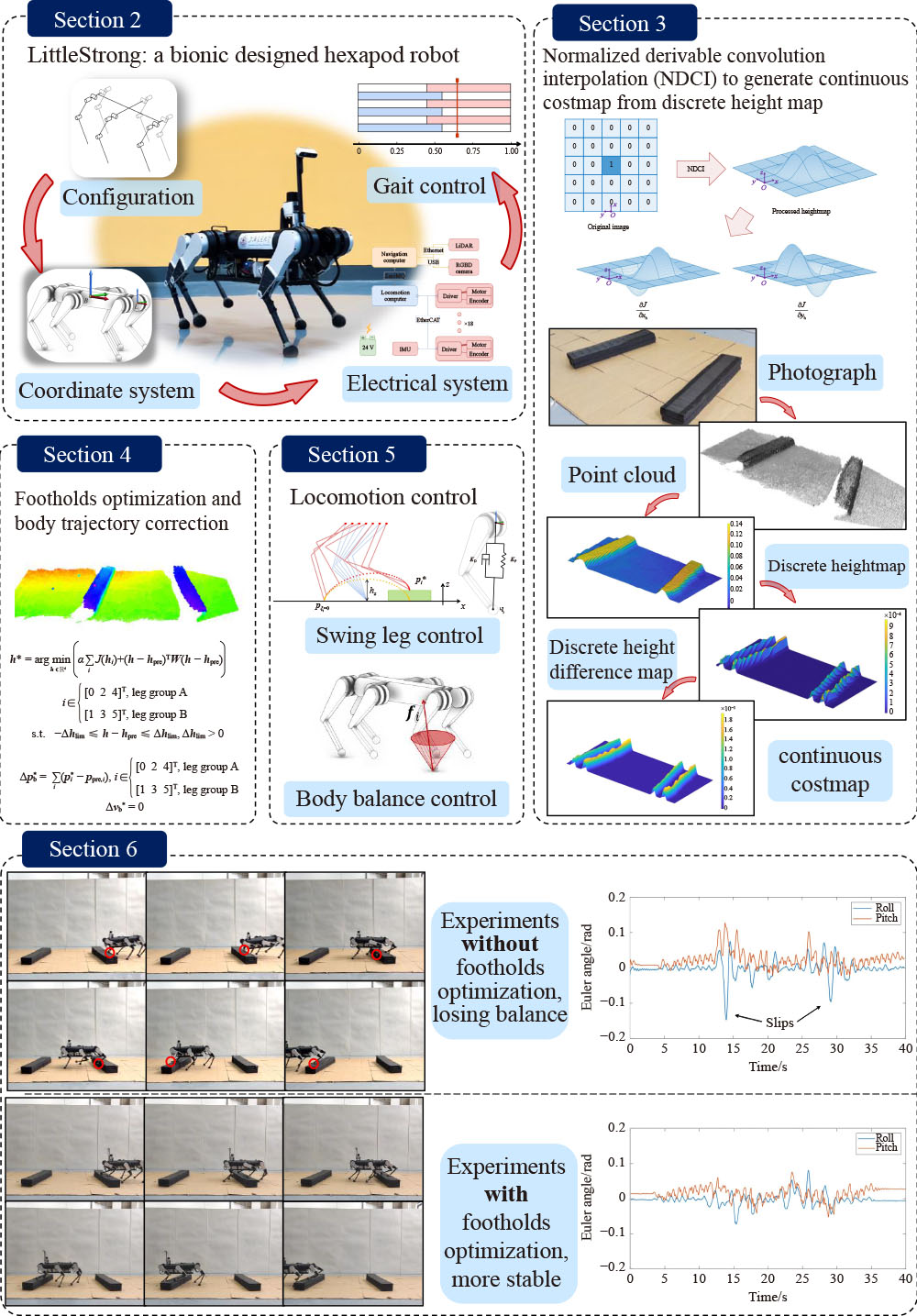| Abbreviations |
| BCS | Body coordinate system |
| CBC | Centroid balance control |
| CI | Convolution interpolation |
| CNN | Convolutional neural network |
| CoM | Center of mass |
| GRF | Ground reaction force |
| IMU | Inertial measurement unit |
| LCS | Leg coordinate system |
| NDCI | Normalized derivable convolution interpolation |
| PCI | Pyramid convolution interpolation |
| RGBD | Red, green, blue, depth |
| SLIP | Spring-loaded inverted pendulum |
| WCS | World coordinate system |
| Variables |
| A | Merged matrix for CBC |
| b, f | Merged vectors for CBC |
| ci, j | Center of the pixel (i, j) on the map |
| C | Matrix of friction cone and upper and lower bound constraints for GRF |
| E | Identity matrix |
| fi | GRF of the ith leg |
| | Virtual feedforward force of the ith leg in the LCS |
| flim | Friction cone and upper and lower bound constraints for GRF |
| | Virtual force of the supporting legs |
| | Virtual force of the ith supporting leg |
| , | Virtual feedforward forces of the ith supporting leg and swing leg in the LCS, respectivley |
| g | Local gravitational acceleration |
| hz | Step height that needs to be raised in the middle of the swing process |
| h | Merged vector of hi |
| h* | Horizontal component of optimized footholds |
| hi | Horizontal component of pi |
| | Optimized horizontal coordinate of the foothold |
| hpre | Merged vector of hpre,i |
| hpre,i | Horizontal component of preplanned foothold |
| Δh | Intermediate variable of the difference between the optimized footholds and the preplanned footholds |
| Δhlim | Maximum amount of adjustment Δpi allowed |
| nΔh | nth element of Δh |
| i | Index for the item, such as the ith leg, or the (i, j) pixel |
| BI | Inertia matrix of the body in the BCS |
| j | Index for the item, such as the (i, j) pixel |
| Ji | Jacobian matrix of the ith leg |
| J (hi) | Terrain cost at the position of hi |
| J (ph) | Cost function for NDCI |
| | Partial derivative of the cost function for NDCI |
| , | Joint damping and stiffness matrices, respectively |
| , | Damping and stiffness of body position, respectively |
| , | Damping and stiffness of body attitude, respectively |
| , | Damping and stiffness of the leg, respectively |
| Bli | Tip position in the BCS |
| , | Position and velocity of the ith leg in the LCS, respectively |
| , | Target position and velocity of the ith leg in the LCS, respectively |
| m, n | Set numbers of pixels that need to be involved |
| | Position of the robot body |
| , , | Target position, velocity, and acceleration of the robot’s CoM, respectively |
| ph | Horizontal coordinate of the position of the selected point on the whole map |
| | Foothold point of the ith leg |
| , , | x, y, and z components of the foothold , respectively |
| | Optimized footholds |
| | Height components at the position on the heightmap |
| | Preplanning of the target foothold |
| | Swing trajectory of the ith leg |
| , | Estimated position and velocity of the robot, respectively |
| | Correction amount on the original body trajectory |
| Δpi | Foothold adjustment for the ith leg |
| Bphip,i | Position of the ith leg’s hip joint in the BCS |
| , | Current angle and angular velocity read by the ith encoder, respectively |
| , | Target angle and angular velocity of the ith joint, respectively |
| R | Current attitude matrix |
| | Desired attitude of the body |
| | Estimated current attitude of the robot |
| | Set of real number |
| S | Selection matrix for CBC |
| tsw,i | Time when the ith leg enters the swing phase |
| Tst, Tsw | Duration of the standing and swing phase, respectively |
| v | Velocity of the body |
| vd | Desired velocity of the body |
| | Speed correction |
| xh | x component of the horizontal coordinate of the position of the selected point on the heightmap |
| xi,j | x component of the center of the pixel (i, j) on the map |
| yh | y component of the horizontal coordinate of the position of the selected point on the heightmap |
| yi,j | y component of the center of the pixel (i, j) on the map |
| W, D, Q | Weighting matrices for footholds optimization |
| α, β, γ, | Weighting factors for footholds optimization |
| δ | Weighting factor for CBC |
| σx, σy | Smoothing factor in x and y directions, respectively |
| ϕ, θ, ψ | Euler angle roll, pitch, and yaw measured by the IMU |
| μ | Number of legs in contact |
| | Control torque of the ith joint |
| ξi | Swing phase |
| | Angular velocity of the body |
| , | Target angular velocity and acceleration of the robot, respectively |
| * | Symbol maps from a vector () to an antisymmetric matrix () |





















